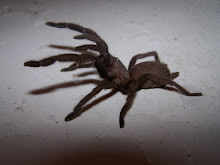Bacterial endosymbiont is a major causative agent of morbidity associated with filarial nematode infections.
Wolbachia is one of my favorite bacteria, I've actually given it it's own label on the blog. It does all sorts of strange things, like dictate the gender of the host’s offspring. Wolbachia lives in the eggs of it’s insect hosts, being passed on from mother to daughter. If they end up in a male, they dead-end because they cannot be passed on through sperm. Instead, they kill any potential male offspring the female has or makes infected males unable to have offspring with uninfected females depending on what species they infect.
However, Wolbachia is actually a somewhat common endosymbiont in insects and nematodes. Although it’s famous for the effects on insects I mentioned earlier, Wolbachia actually has a major role in medicine despite not actually being a human pathogen.
200 million people around the world suffer from a disease called river blindness. This disease is spread by parasitic flies through the bite. When a fly bites a human, it injects nematode larvae in it’s saliva. Once inside the body, these nematodes form nodules under the skin. They mate and then produce larvae which migrate through the skin, looking to be taken up again by a Simulium host.
The larvae when alive don’t really cause a whole lot of damage. Being a parasite, they’ve evolved ways to become invisible to the host’s immune system. The damage from river blindness comes from when the nematodes die. When they die, they become visible to the host’s immune system which subsequently responds, with many different responses but inflammation is the response responsible for the damage that causes the blindness. If the larva happens to be in the eye when this happens, then this can be very serious.
However, the nematode’s body isn’t the only thing that causes the immune response. Scientists studying Onchocerca volvulus have discovered that the effects of the dying larvae are greatly excasterbated by their Wolbachia endosymbiont.
Scientists took extracts from nematodes, nematodes treated with an antibiotic and nematodes that didn’t harbor Wolbachia and injected them into the eyes of mice. Nematodes treated with the antibiotic doxycycline as well as nematodes which don’t harbor Wolbachia triggered less of an immune response than did nematodes who had Wolbachia endosymbionts. To the scientists, this indicated that something in the Wolbachia cells and not the nematode cells caused the inflammation and other immune responses.
But what in the Wolbachia cells could trigger a response?
Wolbachia are a gram-negative bacteria, which means that a major portion of their outer cell wall is formed from a macromolecule called bacterial lipopolysaccaride (LPS). A receptor called Toll Like Receptor 4 (TLR4) is a major part of response to bacterial infection. Since TLR4 responds to LPS, it was a natural candidate for testing.
To test the link between the Wolbachia LPS and the immune response, the researchers used mice with a mutation in the TLR4 gene that made them less sensitive to LPS to determine if this was the cause. Once again, extracts containing Wolbachia were injected into the mice and their immune responses measured.
As one would expect, those mice with an underresponsive TLR4 receptor displayed less severe symptoms than did mice with a normal TLR4 gene. This means that instead of the nematodes causing the inflammation and other immune responses associated with river blindness, it’s actually their endosymbionts that cause those types of problems.
This opens up a whole new avenue of potential research into new treatments for river blindness. Since we now know that it is not the larvae that cause river blindness we can focus on the real culprit, Wolbachia. The Wolbachia are vital endosymbionts-the nematodes don’t properly develop without the bacteria in the system. This means by focusing our efforts on Wolbachia we not only prevent the LPS from the Wolbachia being released when the filarae die, we drastically reduce the numbers of said filarae because without the Wolbachia the nematodes are unable to reproduce.
Saint Andre, A.V., Blackwell, N.M., Hall, L.R., Hoerauf, A., Brattig, N.W., Volkmann, L., Taylor, M.J., Ford, L., Hise, A.G., Lass, J.H. (2002). The Role of Endosymbiotic Wolbachia Bacteria in the Pathogenesis of River Blindness. Science, 295(5561), 1892-1895.
Labels: Medical blogging, Peer-reviewed research, Wolbachia


0 Comments:
Post a Comment
Subscribe to Post Comments [Atom]
<< Home